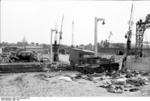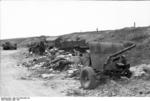Universal Carrier
| Country | United Kingdom |
| Primary Role | Other |
Contributor: Alan Chanter
ww2dbaseWidely used by British Commonwealth forces throughout the Second World War the Universal Carrier was developed in 1940 as a replacement for the variety of tracked carriers of the Bren and Scout types which had been in British Army service since 1934. The demand for tracked carriers to fill a variety of functions resulted in a desire to standardize the basic vehicle so that, with only small modification kits fitted during the manufacturing stage, the Universal Carrier (in spite of the official title it remained the Bren carrier to almost everybody), could be adapted to almost fill any required role.
ww2dbaseMechanically the same as the earlier carrier designs, the Universal Carrier was powered by a Ford Flathead V-8 petrol engine which drove the tracks via rear sprockets. Steering was by lateral displacement of the front bogie unit for gentle turns, with track braking for more abrupt turns. The new design, with room for three men, incorporated improved armour plating all over the vehicle and particularly around the compartments on either side of the engine. Mud deflectors were located over the tracks and steps for entry were sited at the rear. Although the driver's and gunner's compartments were very much the same in all carriers, the position of the armoured open-top rear compartments could differ.
ww2dbaseFor the Universal Carrier both British and imported Ford engines were used. Initially British and imported American-built engines were rated at 65-bhp and the Canadian ones at 95-bhp although by the end of the war the War Office rated them all at 85-bhp. Engines from all three sources were inter-changeable.
ww2dbaseSome 40,000 or more Carriers of the Universal and later associated types were built in the United Kingdom during World War II but, such was the requirement that it was felt necessary for other Commonwealth countries to undertake production too. Some 29,000 Universal Carriers were built in Canada to a similar specification to the U.K. version plus 5,000 of the larger Windsor Carriers. Australia built 5,600 standard Universal Carriers to U.K. design although they were simplified mechanically in that the track displacement device for steering was omitted, and later Australian carriers had a modified hull with a sloping glacis plate. Welded construction was used - a feature employed only in a few models built in the U.K. The earliest New Zealand carriers were built from plans sent from the United Kingdom, although later models would be more like the Australian ones. The US Army, considering the Universal to be overloaded and underpowered, set about improving it. They developed the "Carrier T16", with a longer body and track and more powerful engine; Although 2,600 T16s were built, somewhere the Americans had got the sums wrong and the T16 could not carry as much payload as the standard Universal, nor was it as reliable, so that few were ever put to use. In total factories in Britain, Canada, the USA, Australia and New Zealand turned out roughly 81,700 vehicles during the war years, with a further 31,300 completed in the post-war period. Ultimately some 113,000 Universals would be built by 1960 in the United Kingdom and abroad, making it the most produced armoured fighting vehicle in history.
ww2dbaseThe popular Universal Carriers were generally used to transport personnel and equipment, particularly support weapons, or as machine gun platforms. With modification kits there were a number of derivatives to allow for use as artillery observation post, mortar carrier or flamethrower (Wasp) and various marks and sub-marks whose only essential differences was in engines. The Mark II version for instance included some improvements, such as a spare road wheel as a standard fitting, a larger kit box on the rear of the hull, and either one or two foot-step brackets each side of the hull. Further improvements were incorporated in the Mark III carrier.
ww2dbaseIn 1942 an experimental version of the Australian carrier with a stronger, lengthened chassis was built as a mounting for the 2-pounder anti-tank gun. The Ford V-8 engine was brought forward alongside the driver and the gun, on a field mounting with shield, was mounted on a turntable at the rear. Trials of the 2-pounder carrier showed various faults; among others it rode badly, was slow and underpowered; was insufficiently strong and mechanical components failed; the driver was too cramped and the crew and gun were inadequately protected. It did not, therefore, go into series production.
ww2dbaseAt least 2,600 were sent to the Red Army, and were mainly used as armoured personnel carriers (APCs), reconnaissance and command vehicles. The Soviets, however, criticized the type's battlefield mobility, considering that the narrow tracks did not perform well in deep snow and mud.
ww2dbaseProduction of Universal Carriers began in 1934 and did not cease until 1960. Some of the manufacturers were:
ww2dbaseUnited Kingdom:
Thorneycroft Motors, Basingstoke
Wolseley Motors
Sentinel Steam Wagon Co, Shrewsbury
Aveling-Barford Ltd.
Ford Motor Co., Dagenham
ww2dbaseCanada:
Ford Motor Co. of Canada, Windsor, Ontario
ww2dbaseNew Zealand:
General Motors of New Zealand
ww2dbaseAustralia:
South Australian Railways Workshop, Adelaide/p>
ww2dbaseUnited States:
Ford Motor Company, Massachusetts
ww2dbaseSources:
B. T. White: Tanks and other Armoured Fighting Vehicles 1942-45 (Blandford Press, 1972)
Ian V. Hogg and John Weeks: The Illustrated Encyclopedia of Military Vehicles (Hamlyn Publishing, 1980)
David Porter: World War II Soviet Weapons (Anber Books, 2018)
Last Major Revision: Dec 2020
SPECIFICATIONS
Universal Carrier
| Machinery | Ford Flathead V8 petrol engine rated at 85bhp |
| Suspension | Horstmann Type |
| Armament | 1x.303-in hull-mounted Bren light machine gun or 1x.55in Boys anti-tank rifle |
| Armor | 7-10mm |
| Crew | 3 |
| Length | 3.65 m |
| Width | 2.06 m |
| Height | 1.57 m |
| Weight | 3.8 t |
| Speed | 48 km/h |
| Range | 250 km |
Photographs
 |  |
Please consider supporting us on Patreon. Even $1 per month will go a long way! Thank you. Please help us spread the word: Stay updated with WW2DB: |
- » US Women's Army Corps "Six Triple Eight" Awarded with Congressional Gold Medal (30 Apr 2025)
- » Wreck of Soviet Submarine M-49 Found (10 Apr 2025)
- » Japanese Emperor Visited Iwoto (Iwo Jima) (8 Apr 2025)
- » Race, Holocaust, and African-American WW2 Histories Removed from the US Naval Academy Library (7 Apr 2025)
- » US Government Plans to Purge WW2 Information (17 Mar 2025)
- » See all news
- » 1,167 biographies
- » 337 events
- » 44,642 timeline entries
- » 1,244 ships
- » 350 aircraft models
- » 207 vehicle models
- » 376 weapon models
- » 123 historical documents
- » 261 facilities
- » 470 book reviews
- » 28,517 photos
- » 365 maps
Joachim von Ribbentrop, German Foreign Minister, Aug 1939